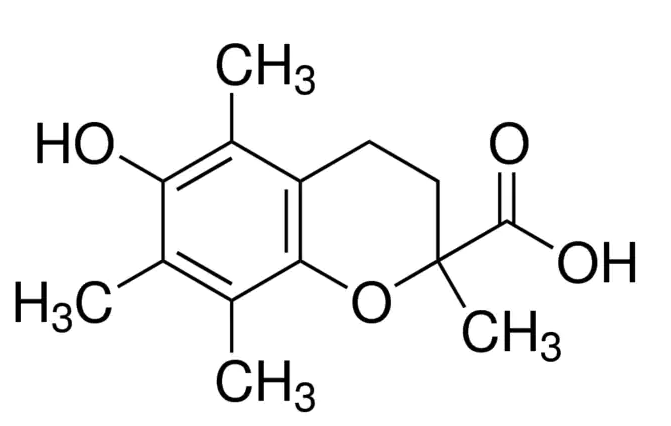6-HYDROXY-2,5,7,8-TETRAMETHYLCHROMAN-2-CARBOXYLIC ACID CAS#: 53188-07-1; ChemWhat Code: 818747
Identification
| Product Name | 6-HYDROXY-2,5,7,8-TETRAMETHYLCHROMAN-2-CARBOXYLIC ACID |
| IUPAC Name | 6-hydroxy-2,5,7,8-tetramethyl-3,4-dihydrochromene-2-carboxylic acid |
| Molecular Structure |  |
| CAS Registry Number | 53188-07-1 |
| EINECS Number | 258-422-8 |
| MDL Number | MFCD00006846 |
| Beilstein Registry Number | 1384051 |
| Synonyms | trolox(+/-)-6-hydroxy-2,5,7,8-tetramethylchromane-2-carboxylic acid6-hydroxy-2,5,7,8-tetramethyl-chroman-2-carboxylic acid(±)-6-hydroxy-2,5,7,8-tetramethylchromane-2-carboxylic acid(±)-6-hydroxy-2,5,7,8-tetramethylchroman-2-carboxylic acidtrolox C6-hydroxy-3,4-dihydro-2,5,7,8-tetramethyl-2H-1-benzopyran-2-carboxylic acid(±)-6-hydroxyl-2, 5, 7, 8-tetramethylchromane-2-carboxylic acid(±)-6-hydroxyl-2,5,7,8-tetramethlychromane-2-carboxylic acid(±)-6-hydroxy-2,2,7,8-tetramethylchroman-2-carboxylic acid6-hydroxy-2,5,7,8-tetramethyl-2-carboxylic acid |
| Molecular Formula | C14H18O4 |
| Molecular Weight | 250.29 |
| InChI | InChI=1S/C14H18O4/c1-7-8(2)12-10(9(3)11(7)15)5-6-14(4,18-12)13(16)17/h15H,5-6H2,1-4H3,(H,16,17) |
| InChI Key | GLEVLJDDWXEYCO-UHFFFAOYSA-N |
| Canonical SMILES | Cc1c(c2c(c(c1O)C)CCC(O2)(C)C(=O)O)C |
| Patent Information | ||
| Patent ID | Title | Publication Date |
| WO2019/70917 | COMPOUNDS AND COMPOSITIONS FOR INHIBITING RETINAL PIGMENT EPITHELIUM DEGENERATION AND METHODS USING THE SAME | 2019 |
| CN110305119 | Trolox ester type derivative as well as preparation method and application thereof | 2019 |
Physical Data
| Appearance | White to beige powder |
| Solubility | No data available |
| Flash Point | No data available |
| Refractive index | No data available |
| Sensitivity | No data available |
| Melting Point, °C | Solvent (Melting Point) |
| 189 – 191.5 |
Spectra
| Description (NMR Spectroscopy) | Nucleus (NMR Spectroscopy) | Solvents (NMR Spectroscopy) | Temperature (NMR Spectroscopy), °C | Frequency (NMR Spectroscopy), MHz | Original Text (NMR Spectroscopy) |
| Chemical shifts | 1H | chloroform-d1 | 400 | 1H NMR (CDC13, 400 MHz): δ 4.34 (br, s 1H), 3.61 (s, 1H), 2.75 – 2.55 (m, 2H), 2.45 – 2.30 (m, 1H), 2.18 (s, 6H), 2.10 (s, 3H), 1.94 (ddd, J = 2.8, 5.2 12 Hz, 1H), 1.62 (s, 3H); | |
| Spectrum | 1H | water-d2 | 29.84 | 600 | |
| Chemical shifts | 13C | dimethylsulfoxide-d6, aq. phosphate buffer | 125.71 | ||
| Chemical shifts | 13C | CDCl3 | 75.5 |
| Description (IR Spectroscopy) | Solvent (IR Spectroscopy) | Temperature (IR Spectroscopy), °C |
| Intensity of IR bands, Bands, Spectrum | potassium bromide | |
| Intensity of IR bands, Bands | ||
| Mid IR (MIR), Intensity of IR bands, Bands, Spectrum | deuterated methanol | |
| Mid IR (MIR), Intensity of IR bands, Bands, Spectrum | water-d2 | |
| Spectrum | KBr | 24.85 |
| Spectrum | acetonitrile | -40.15 |
| Description (Mass Spectrometry) | Comment (Mass Spectrometry) |
| liquid chromatography mass spectrometry (LCMS), electrospray ionisation (ESI), time-of-flight mass spectra (TOFMS), spectrum | |
| liquid chromatography mass spectrometry (LCMS), spectrum | |
| liquid chromatography mass spectrometry (LCMS), APCI (atmospheric pressure chemical ionization), tandem mass spectrometry, spectrum | |
| spectrum, chemical ionization (CI) | FAB (fast atom bombardment) |
| Description (UV/VIS Spectroscopy) | Solvent (UV/VIS Spectroscopy) | Absorption Maxima (UV/VIS), nm | Ext./Abs. Coefficient, l·mol-1cm-1 |
| Spectrum | aq. phosphate buffer | ||
| Spectrum | lithium hydroxide monohydrate, sodium hydroxide | ||
| Spectrum | water-d2, aq. phosphate buffer | 560, 380 | |
| dimethyl sulfoxide, lithium hydroxide monohydrate | 294 |
Route of Synthesis (ROS)
| Conditions | Yield |
| With lithium aluminium tetrahydride In tetrahydrofuran at 0 – 80℃; for 6h; | 93% |
| With lithium aluminium tetrahydride In tetrahydrofuran Reflux; | 93% |
| With lithium aluminium tetrahydride In tetrahydrofuran at 4℃; Reflux; | 85% |
Safety and Hazards
| Pictogram(s) |  |
| Signal | Warning |
| GHS Hazard Statements | H315 (100%): Causes skin irritation [Warning Skin corrosion/irritation] H319 (100%): Causes serious eye irritation [Warning Serious eye damage/eye irritation] H335 (100%): May cause respiratory irritation [Warning Specific target organ toxicity, single exposure; Respiratory tract irritation] Information may vary between notifications depending on impurities, additives, and other factors. |
| Precautionary Statement Codes | P261, P264, P264+P265, P271, P280, P302+P352, P304+P340, P305+P351+P338, P319, P321, P332+P317, P337+P317, P362+P364, P403+P233, P405, and P501 (The corresponding statement to each P-code can be found at the GHS Classification page.) |
Other Data
| Transportation | Under the room temperature and away from light |
| HS Code | 2932999099 |
| Storage | Under the room temperature and away from light |
| Shelf Life | 2 years |
| Market Price | USD |
| Druglikeness | |
| Lipinski rules component | |
| Molecular Weight | 250.295 |
| logP | 2.008 |
| HBA | 2 |
| HBD | 2 |
| Matching Lipinski Rules | 4 |
| Veber rules component | |
| Polar Surface Area (PSA) | 66.76 |
| Rotatable Bond (RotB) | 1 |
| Matching Veber Rules | 2 |
| Use Pattern |
| 6-HYDROXY-2,5,7,8-TETRAMETHYLCHROMAN-2-CARBOXYLIC ACID CAS#: 53188-07-1 drug formulation for delivering a therapeutic agent to treat ear disorders |
| food composition for whitening skin |
| cosmetic composition for whitening skin |
Buy Reagent | |
| No reagent supplier? | Send quick inquiry to ChemWhat |
| Want to be listed here as a reagent supplier? (Paid service) | Click here to contact ChemWhat |
Approved Manufacturers | |
| Watsonnoke Scientific Ltd | https://www.watsonnoke.com/ |
| Want to be listed as an approved manufacturer (Requires approvement)? | Please download and fill out this form and send back to approved-manufacturers@chemwhat.com |
Other Suppliers | |
| Watson International Limited | Visit Watson Official Website |
Contact Us for Other Help | |
| Contact us for other information or services | Click here to contact ChemWhat |



